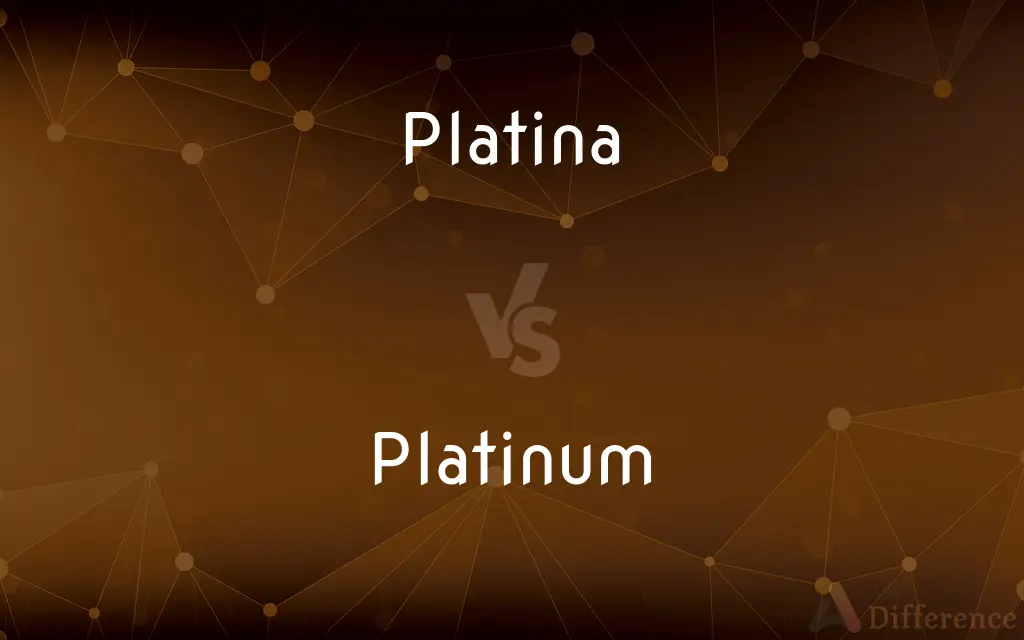Platina vs. Platinum — What's the Difference?
By Tayyaba Rehman & Maham Liaqat — Updated on April 5, 2024
Platina often refers to raw platinum ore or unrefined platinum, characterized by its natural state, whereas platinum is a highly valuable, dense, and malleable metal used in jewelry and industry.

Difference Between Platina and Platinum
Table of Contents
ADVERTISEMENT
Key Differences
Platina, historically used to describe raw platinum ore, highlights the metal in its natural, unrefined form. On the other hand, platinum refers to the purified, processed form of the metal, known for its exceptional durability and shine.
Platina, in its raw form, may contain various impurities and other platinum-group metals, which can affect its appearance and properties. Whereas platinum, once refined, is highly pure, typically over 95%, making it ideal for fine jewelry and industrial applications.
The term platina is less commonly used today and is often considered outdated. Meanwhile, platinum is widely recognized and valued for its rarity, making it a symbol of prestige and luxury.
Platina's historical significance lies in its initial confusion with silver when first discovered. Platinum, however, has established itself as a distinct and valuable metal, far surpassing silver in value and applications.
While platina might be encountered in discussions of mineralogy or history, platinum is a standard term in contemporary contexts, from jewelry to automotive catalytic converters.
ADVERTISEMENT
Comparison Chart
Definition
Raw, unrefined platinum ore
Pure, refined metal
Purity
Contains impurities
Over 95% pure
Usage
Historical, mineralogical
Jewelry, industry, investment
Appearance
May appear dull due to impurities
Shiny, white metal
Modern Relevance
Mostly of historical interest
Highly valued and widely used
Compare with Definitions
Platina
Historically confused with silver.
Early explorers dismissed platina, mistaking it for an inferior form of silver.
Platinum
Symbol of prestige and wealth.
Platinum credit cards offer higher benefits and are seen as status symbols.
Platina
Less commonly used term today.
The term platina is rarely used in modern contexts, overshadowed by the term platinum.
Platinum
Resistant to corrosion and high temperatures.
Platinum is used in laboratory equipment for its exceptional resistance to heat.
Platina
Of interest primarily to mineralogists and historians.
Platina is studied for its historical significance in the development of metal refining techniques.
Platinum
Highly valuable, dense metal used in jewelry and industry.
Platinum rings are prized for their durability and luster.
Platina
Contains various metals and impurities.
Platina often includes other elements like iridium and palladium before refinement.
Platinum
Over 95% pure after refinement.
Refined platinum is used in catalytic converters due to its high purity and reactivity.
Platina
Raw platinum ore; unrefined.
Miners extracted platina, which would later be refined into pure platinum.
Platinum
Widely recognized and valued.
Platinum is considered more valuable than gold in many applications due to its rarity and physical properties.
Platina
Platinum, especially as found naturally in impure form.
Platinum
Platinum is a chemical element with the symbol Pt and atomic number 78. It is a dense, malleable, ductile, highly unreactive, precious, silverish-white transition metal.
Platina
Platinum.
Platinum
A trademark for a certification indicating that a recording, such as an album of music, has sold a million copies.
Platina
Platinum.
Platinum
Symbol Pt A silver-white metallic element occurring in alluvial deposits in sperrylite and nickel ores, usually mixed with other metals such as iridium, osmium, or nickel. It is ductile and malleable, does not oxidize in air, and is used as a catalyst and in electrical components, jewelry, dentistry, and electroplating. Atomic number 78; atomic weight 195.08; melting point 1,768.2°C; boiling point 3,825°C; specific gravity 21.45 (20°C); valence 2, 3, 4. See Periodic Table.
Platinum
A medium to light gray.
Platinum
The chemical element with atomic number 78 and symbol Pt; a dense, malleable, ductile, highly unreactive, silverish-white transition metal of great value.
Platinum
A whitish grey colour, like that of the metal.
Platinum
(music) A single or album that has achieved platinum sales, i.e. over 1 million or 2 million.
Platinum
A platinum-based drug: a platin#Etymology 2.
Platinum
Of a whitish grey colour, like that of the metal.
Platinum
Of a musical recording that has sold over one million copies (for singles), or two million (for albums).
Platinum
Very expensive, or of very high quality
We can offer the platinum service for fifty dollars extra.
Platinum
(computer games) to reach platinum level in a game
I platinumed in Clash of Clans yesterday.
Platinum
A metallic element of atomic number 78, one of the noble metals, classed with silver and gold as a precious metal, occurring native or alloyed with other metals and also as the platinum arsenide (sperrylite). It is a heavy tin-white metal which is ductile and malleable, but very infusible (melting point 1772° C), and characterized by its resistance to strong chemical reagents. It is used for crucibles in laboratory operations, as a catalyst, in jewelry, for stills for sulphuric acid, rarely for coin, and in the form of foil and wire for many purposes. Specific gravity 21.5. Atomic weight 195.1. Symbol Pt. Formerly called platina.
Platinum
A heavy precious metallic element; gray-white and resistant to corroding; occurs in some nickel and copper ores and is also found native in some deposits
Common Curiosities
How is platinum different from platina?
Platinum is the purified form of platina, refined to over 95% purity and used in numerous applications.
What were early misconceptions about platina?
Early on, platina was often mistaken for silver or considered a nuisance by gold miners.
What is platina?
Platina refers to raw, unrefined platinum ore, often containing various impurities.
Can platina be used to make jewelry?
Platina must be refined into platinum before it can be used to make high-quality jewelry.
What makes platinum a symbol of prestige?
Its rarity, luster, and the high cost of extraction and refinement contribute to platinum's status as a symbol of wealth and prestige.
How does the rarity of platinum affect its price?
The scarcity of platinum significantly contributes to its high price compared to other metals.
Why is platinum considered valuable?
Its rarity, durability, and resistance to corrosion make platinum highly valuable for jewelry, industrial use, and as an investment.
How are platina and platinum extracted?
Both are extracted from platinum ore, but platinum undergoes additional refinement processes to achieve high purity.
How is platinum used in industry?
Platinum's high melting point and resistance to corrosion make it ideal for use in catalytic converters, laboratory equipment, and electronics.
Is platinum more valuable than gold?
In many cases, yes, due to its physical properties and lower abundance in the earth's crust.
What does the term platinum signify in marketing?
In marketing, platinum often denotes the highest quality or level of service, reflecting the metal's prestige.
Why is platina considered of historical interest?
Platina's role in the early confusion and development of metal refining techniques makes it of interest to historians.
What is the significance of platinum in modern technology?
Its use in catalytic converters, electronics, and medical devices underscores platinum's importance in modern technology.
Can platinum be recycled?
Yes, platinum is highly recyclable, with a significant portion of its supply coming from recycled materials.
Are there any cultural or symbolic meanings associated with platinum?
Platinum is often associated with exclusivity, endurance, and high status in various cultures.
Share Your Discovery

Previous Comparison
Cognizant vs. Conscious
Next Comparison
Observe vs. TeachAuthor Spotlight
Written by
Tayyaba RehmanTayyaba Rehman is a distinguished writer, currently serving as a primary contributor to askdifference.com. As a researcher in semantics and etymology, Tayyaba's passion for the complexity of languages and their distinctions has found a perfect home on the platform. Tayyaba delves into the intricacies of language, distinguishing between commonly confused words and phrases, thereby providing clarity for readers worldwide.
Co-written by
Maham Liaqat














































